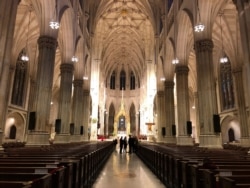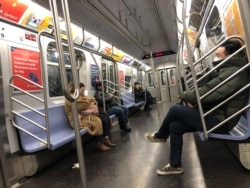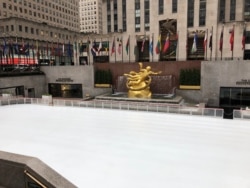The famous "luck of the Irish" met its match this St. Patrick's Day in the form of the coronavirus.
New Yorkers woke up to a wet and gray Tuesday, as they continued to grapple with their new reality. Mayor Bill de Blasio said confirmed cases of the potentially deadly virus are expected to hit 1,000 this week in the city of 8.6 million.
New restrictions went into place Monday forbidding large gatherings, prohibiting restaurants and bars from serving patrons on-site, and urging people to keep two meters (six feet) away from each other.
Normally on March 17, about 2 million spectators dressed in green line a 35-block route along Fifth Avenue to view the dozens of marching bands, bagpipers, police, firemen, politicians and personalities along the route. Legend has it that St. Patrick wore green when he drove all the snakes out of Ireland in 461 A.D.
The parade goes past a soaring Gothic cathedral built by Irish immigrants and named for St. Patrick, who is the patron saint of both Ireland and New York City. The cathedral has remained open to worshipers, but Mass has been canceled.
Fifth Avenue was mostly quiet Tuesday and there were no revelers. For the first time in its 258-year history, the parade was canceled due to the health risks of large crowds.
But at 11 a.m., the time when the parade kicks off each year, Patrick Grennan, Coleen Brady and Richard McKenna took their positions at 44th Street, turned on a speaker with bagpipe music, unfurled their Irish and American flags, and began to march up Fifth Avenue.
"We figured even if it's only a handful of us, the Irish are going to march on Fifth Avenue today," Grennan said.
Buses and taxis buzzed along the avenue, but not nearly as many as on a typical business day, and there was no evidence of the mobs of tourists who are normally in the Rockefeller Center area around the cathedral.
Jake, 25, from England was one of the very few. He and his friend Don arrived Sunday, and they say they've been making the best of the situation.
"We went up the Empire State building, we managed to eat out a few times and do a few shops," he said. "It's just nice to the see the city as it is." The Empire State Building has since closed to tourists, according to its website.
Jake said he wasn't put off by concerns he could catch the coronavirus, which is also rampant in Britain. "We see it as same as being at home —if we are going to get it, we are going to get it. We just take sensible precautions."
Economic troubles
It is only the second day of public school closings, teleworking and restrictions on businesses, but already it is evident the virus is economically crippling the city.
"There is no business," said Bobby, who manages Little Italy Pizza in midtown, which serves the office workers who normally occupy the neighboring skyscrapers. "There are no people." He said business is down at least 90%.
Thousands of jobs in the local economy depend on the 50 million visitors who come to the Big Apple each year. And while many New Yorkers grumble about the tourists clogging up the streets, they know many of their neighbors depend on them to earn a living.
At a Starbucks that was preparing to shut down, Rafi, a lawyer who works nearby, bought a cup of coffee and said he is anxious about the long-term economic impact.
"Not just the airlines, or the restaurants or the bar industry, but everything," he said.
"Every level of the economy from Wall Street to any small street bodega [small grocery shop] in Queens or Brooklyn, they are affected."
Along Fifth Avenue, many of the luxury shops have closed or are operating on shortened hours. Many of the bars and restaurants, which see some of their best business on St. Patrick's Day, are shuttered.
On 43rd Street, Benny and his colleague were unloading packages from a delivery truck. He said commercial and retail deliveries have dropped off, but residential deliveries are up because so many New Yorkers are avoiding crowded stores and working from home.
"Those people are ordering a lot more than usual, so the residential routes are very heavy now, and they are getting heavier as we go," he said.
In Times Square, famous for its electronic billboards, one now reminds people that "Staying home means saving lives." Nearby, Broadway shows have gone dark, city museums and other prime tourist spots have closed or gone quiet. You can get a seat, or actually a whole row of seats, on the subway during rush hour.
After a week of panic buying, the city's grocery stores have mostly bare shelves, and supermarket staffers are now in the category of heroic workers, like first responders.
New Yorkers are known for their resilience. After the terrorist attacks of 9/11, the city was back on its feet in a matter of weeks. But this time, some say, it feels different.
"With 9/11, it was just New York City," Rafi the lawyer says. "It was downtown, and we knew the enemy. Here, we know the enemy, but there is nothing we can do about it."










